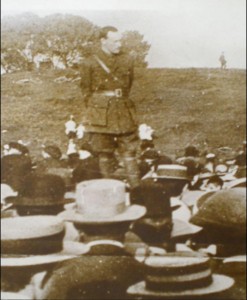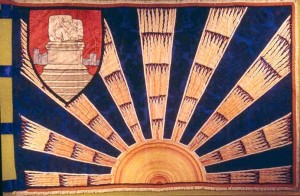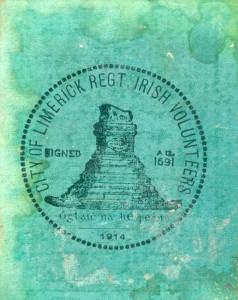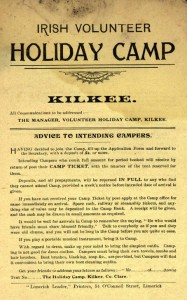“To maintain the rights and liberties common to all the people of Ireland.”- The Launch of the Limerick Volunteers, 1914.

Liam Hogan remembers the founding of the Irish Volunteers in Limerick city in 1914.
The 25th of January 2014 marked the 100th anniversary of the launch of the Limerick corps of the Irish Volunteers. This inaugural public meeting was held at the Athenaeum Hall on Cecil Street on a cold Sunday night. As the crowds arrived at the hall, handbills were circulated which aimed to reassure those present that the Volunteer movement was not a threat to Home Rule.
The handbill stated that the Irish Volunteers were apolitical and open to “Irishmen of every creed and class” which would help to “maintain the rights and liberties common to all the people of Ireland.” The symbolism on display that night was carefully arranged. Projected on to a screen in the hall was a “lime-light” picture of the Sarsfield Monument as well as a picture of the Assembly of the Volunteers at College Green in 1782.
The Irish Volunteers were founded in Limerick city on January 25th 1914 at a meeting addressed by, among others Padraig Pearse and Roger Casement.
Of course while both of these evocative images were of Nationalist movements, neither was Republican. This is all the more surprising when you consider that the provisional committee included multiple members of the Irish Republican Brotherhood (IRB) (including George Clancy the future Sinn Fein Mayor of Limerick who was murdered by British forces in 1921). It is hard to know if this was a shrewd, realpolitik decision by the organisers to cloud their true intentions by pre-empting any accusations of “Fenianism” or simply honest admiration.
The content of Padraig Pearse’s speech appears to point us to the latter conclusion. Kathleen Clarke maintains that this sleight of hand was part of IRB leader Tom Clarke’s long term strategy. Another reason was the strong presence on the committee of the Ancient Order of Hibernians (AOH) (including Michael Colivet the future Sinn Fein TD for the city) which at that time was an unofficial auxiliary of the Irish Parliamentary Party.
Playing down the radical character of the Volunteer movement was probably wise. One can only imagine the reaction in the offices of the anti-Home Rule Limerick Chronicle if their reporter had returned with an account of a militarist meeting in the city which featured images of Robert Emmett and rebel pikemen.
Amongst those on the platform were – Philip O’Donovan (Mayor of Limerick), Sir Roger Casement, Pádraig Pearse (Gaelic League/IRB), Michael O’Callaghan (Sinn Féin), James Leddin (IRB/Sinn Féin), P.J. O’Farrell, J. Comerton (Principal of the Limerick Municipal Technical Institute), Sean O’Muirthuille and R.P. O’Connor (AOH).
Speech by the Mayor

First to speak was the Redmondite Mayor of Limerick, Phillip O’Donovan, who was greeted by a warm round of applause. His speech, however, did not fully reciprocate this positivity.
He stated that he knew, “very little” about the Volunteer movement and that if it harmed “the cause so ably advocated by Mr. Redmond” he would withdraw his “official support”. Nonetheless he was glad to be reassured by members of the provisional committee of the Limerick Volunteers that this was not the case.
The Redmondite mayor of Limerick Philip O’Donovan gave a somewhat equivocal welcome to the Volunteers’ foundation.
O’Donovan’s (feigned?) ignorance of the Volunteer movement is odd as “all cultural, friendly, political and labour societies” were invited to assist in planning the launch in the City Council Chambers in December 1913. He also claimed in his speech that he was a Mayor “of all sections, without distinction”. This was a questionable assertion in Limerick city of 1914, where no women had the vote and just over 6,000 male citizens were enfranchised out of a population of just under 40,000.
Next, the Honorary Secretary (either J. Lehane or Michael Colivet) read out letters of support from Laurence Kettle and The O’Rahilly, the latter referring to Limerick’s “patriotic fervour” in the cause of James Clarence Mangan’s “Dark Rosaleen” [Ireland, to the less poetically inclined]. It was then announced that the famous Limerick Fenian, John Daly (who could not attend) had contributed 20 guineas to be spent on Volunteer equipment. Daly had set up the Limerick Sluagh of Na Fianna Éireann which boasted 250 members in 1912, the largest in the country at that time.
Speech by Padraig Pearse

Next to speak at the podium was Padraig Pearse, who was greeted with “loud applause”. According to Kathleen Daly, Pearse had been co-opted into the IRB in November 1913 by her husband, and influential Fenian, Tom Clark. His speech to the crowd in Limerick welcomed the Volunteer movement but was cautious and conditional. Pearse compared the current crop of Volunteers to those that demanded Free Trade in 1782, and how “bearing arms” could be used to “guarantee liberty”.
He stressed that the Volunteers were not being asked to join a “new political movement” as the “movement had no politics, save being on the side of Ireland.” He then reiterated what the Mayor said and claimed that if the Volunteers were used to damage Home Rule he “would not give it any countenance”. This statement was met with applause and shouts of “hear, hear”. But Pearse was concerned at the concessions being made “behind closed doors” to Unionists in Ulster. He asked, “why was the Home Rule Bill having its chances imperilled when it was safe under the Parliament Act?” His answer – “because Ulster had armed against Home Rule.”
Pearse argued that nationalists had to arm to prevent the Ulster Volunteers from blocking Home Rule.
For Pearse there was a lesson here. He explained that “If Ulster threatened Civil War when Home Rule came, let Ireland be prepared for it.” He followed this with a telling statement, “be also prepared if Home Rule did not come.” In a hint at the many Nationalist groups vying for supremacy behind the scenes, Pearse said “there is too much talk about who were Nationalists, for there is only one dividing line – those for Ireland and those against it.”
Pearse was acclaimed by the crowd and took his seat. Next up to speak was Sir Roger Casement.
Speech by Sir Roger Casement

Casement was given a rapturous reception, and began his speech in an unexpected and politically tone deaf fashion. Despite the still high tensions due to the 1913 Lockout (which saw Laurence Kettle, employer of ‘scab’ labour, being booed off the stage at the launch of the Volunteers in November 1913) he hailed the action of the South African Government in putting down an ongoing strike by utilising their Volunteer Army. Casement, who was staunchly pro-Boer, described how they had previously “put up the greatest fight against the greatest Empire in the world” to gain self-rule. Without such Boer volunteerism “they would have no self-government.”
In a glowing reference to child soldiers, he explained how “little boys of 12 years of age went out and fought with their fathers and died beside them.” Applause followed. “In South Africa they now had self-government and were living in peace and happiness and in utmost loyalty to the Empire, and they had these blessings because they were not afraid to bear arms.” He then lauded the Ulster Volunteers for taking a “manly stand” and “if that section were prepared to make a sacrifice, why not the men of the rest of Ireland?”
Roger Casement lauded the resistance put up by Boers as young as 12 for their ‘liberty’
Casement was also convinced that the Volunteer movement would not hamper the Home Rule Bill, and “that it will only strengthen it.” He concluded his speech by saying “the Blacks in Africa were armed to protect their lives and property, and the Indians and the Irish were the only people who had not the right to bear arms!” Loud applause emanated from the crowd.
Speech by Michael O’Callaghan

Mr. O’Callaghan of Sinn Féin was the final speaker and he said that he came to the meeting “to listen rather than to speak” and that “he had learned more in an hour then he ever learning in an hour before.”
He spoke highly of Roger Casement, and in reference to Casement’s humanitarian work in the Congo and Peru, said that he “had won credit for Ireland in every part of the civilised world.” Moving on to the Volunteer movement, he claimed that he was “against militarism” but in favour of a citizen army which would help maintain and protect “the rights and liberties of the people of Ireland, irrespective of creed, class or politics.”
In conclusion he echoed Pearse’s polarising definition of a nationalist, and labelled those who “did not fight for the right of the State” as outlaws and outcasts.
Following O’Callaghan’s speech, Sean O’Muirthille sang the Irish Volunteers’ song in Irish, followed by “A Nation Once Again” sung by Mr. P. O’Kelly., the crowd were on their feet at this point and joined in the singing. According to Alphonsus O’Halloran, nearly every man that attended that night signed up.
Men Only?
One thing you may have noticed about the inauguration of the Limerick Volunteers is the complete absence of women or even any reference to them. The IPP and the AOH had ignored the proposals made for universal suffrage to be included in the Home Rule Bill by Irish suffragettes. For instance John Dillon MP claimed that giving women the vote would be “the end of western civilisation”. Women were being excluded, both literally and politically, from this national conversation.
No women were present at the meeting and neither constitutional nor radical nationalists put issues like women’s suffrage at the top of their agendas.
Despite the fact that Limerick Corporation had passed resolutions in favour of women’s suffrage, the hostile attitude of those in positions of power to universal suffrage represented a general conservatism toward the position of women in society. This was also evident in Limerick in both republican circles (the Fianna Sluagh Lord Edward was against female membership) and at Local Government level. An example of the latter was highlighted during a monthly meeting of the Carnegie Free Library Committee in December 1912.
A letter was read out from a local suffragette, Jane Gibson (IWFL), which suggested that ‘The Irish Citizen’ & ‘Votes for Women’ newspapers should be supplied to the Ladies’ Room (note the segregated reading areas). After some discussion it was agreed that the Rev. Chairman would read an issue of ‘The Irish Citizen’ and report back to the committee. Two months later the “question of supplying the ‘Irish Citizen’ to the Ladies’ Room was allowed to drop.”
In the meantime it was decided by the Committee that the Library would subscribe to the Catholic Truth Society of Ireland and Sinn Fein publications, which are suitably representative of the Volunteer movement in 1914 – Nationalist and Patriarchal. This fact is underlined when you consider the beautiful flag that was made especially for the Limerick City Regiment of the Irish Volunteers. Beautiful, really beautiful until you notice where it was manufactured. Inscribed at the bottom are the words, “Good Shepherd Convent, Limerick.”
Liam Hogan is a librarian and historian. He is a graduate of the University of Limerick and Aberystwyth University and is currently working on his first book, a study of the historical relationship between Limerick and slavery. You can follow him on Twitter @Limerick1914.
See this post on the Limerick riot of 1912 for an example of their work.
Further Reading:
Witness Statement of Alphonsus J. O’Halloran (No. 910), Lieutenant Irish Volunteers and IRA, Limerick (1914 -1921) URL: http://www.bureauofmilitaryhistory.ie/reels/bmh/BMH.WS1700.pdf#page=1
The War of Independence in Limerick (1912 – 1921) by Tom Toomey
Limerick Constitutional Nationalism (1898-1918) by Tadhg Moloney
Irish Nationalist Women, 1900-1918 by Senia Pašeta